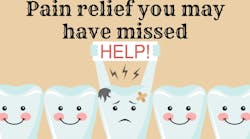One of the biggest challenges hygienists are faced with in clinical care is the expectation of completing many services in a relatively short appointment time. The harsh reality is that the imbalance between hygiene tasks and the actual time allotted often requires the provider to leave things out to stay on schedule. Whether it’s due to a perceived lack of importance, skill, or knowledge, one of the most sacrificed services in these situations is the oral cancer screening. Recent research, however, indicates its necessity with an estimated 54,000 Americans who are diagnosed with oral cancer each year.1 Of those affected, approximately 20% eventually succumb to their diagnosis.1 Dental professionals can save lives through early detection during the hygiene visit, and it only takes minutes.
Extraoral exam
With the patient sitting in an upright position, visually assess their head and neck, looking for any asymmetries or pigmented lesions. Once the chair is leaned back, palpate the patient’s face and jawline, then extend down each side of the neck to feel for any enlarged or hardened lymph nodes. Lymph nodes should also be palpated along the back of the head and neck. After this, lightly rest your fingers over the patient’s thyroid area and instruct them to swallow, ensuring that each side moves symmetrically. Before moving toward an intraoral exam, palpate and visualize the patient’s lips, assessing for changes in color, contour, consistency, and function.
Intraoral exam
Ask the patient to open their mouth, and gently palpate their cheek and lip tissue between the thumb and fingers. Notate any bumps or masses. Using the mouth mirror, visually assess the buccal and gingival tissue by looking for any changes in pigment or consistency. Similarly evaluate the hard and soft palates, and then use the mirror to depress the tongue. Instruct the patient to say “ah” while visualizing the uvula and tonsils, looking for changes in color, size, or deposits in the tissue. Using a piece of cotton gauze, grasp the tip of the tongue and evaluate the lateral, ventral, and dorsal surfaces by stretching it to each side. Once a visual assessment of the tongue is complete, palpate all surfaces to assess for bumps or masses. Finally, instruct the patient to rest the tip of their tongue against the back of their maxillary anterior teeth and assess the floor of the mouth visually and tactilely.
Patient education
Once the oral cancer screening is complete, discuss findings with the patient. For atypical discoveries, involving the dentist for further evaluation is warranted. They may recommend having the patient return for reevaluation, tissue biopsy, or referral to a physician for further testing. Many times, diagnostic evaluation reveals no pathology or need for treatment, which results in a big sigh of relief from everyone. Other times, malignancies may be detected and require swift action by the patient’s medical team.
Dental hygienists are busy individuals with limited time to complete all that is expected. Many times, we are faced with the difficult decision to abbreviate or eliminate items included in the sequence of the appointment to meet the demands of the day. The oral cancer screening is one item that simply can’t be sacrificed. Keeping things simple and consistent will ensure that patients are assessed regularly, and abnormalities can be addressed in their earliest stage. Of all the things we do to add to our patients’ lives, cancer detection is one that our patients will never forget.
Editor's note: This article appeared in the June 2024 print edition of RDH magazine. Dental hygienists in North America are eligible for a complimentary print subscription. Sign up here.
Reference
- Oral cancer. National Institute of Dental and Craniofacial Research. Accessed January 28, 2024. https://www.nidcr.nih.gov/research/data-statistics/oral-cancer









